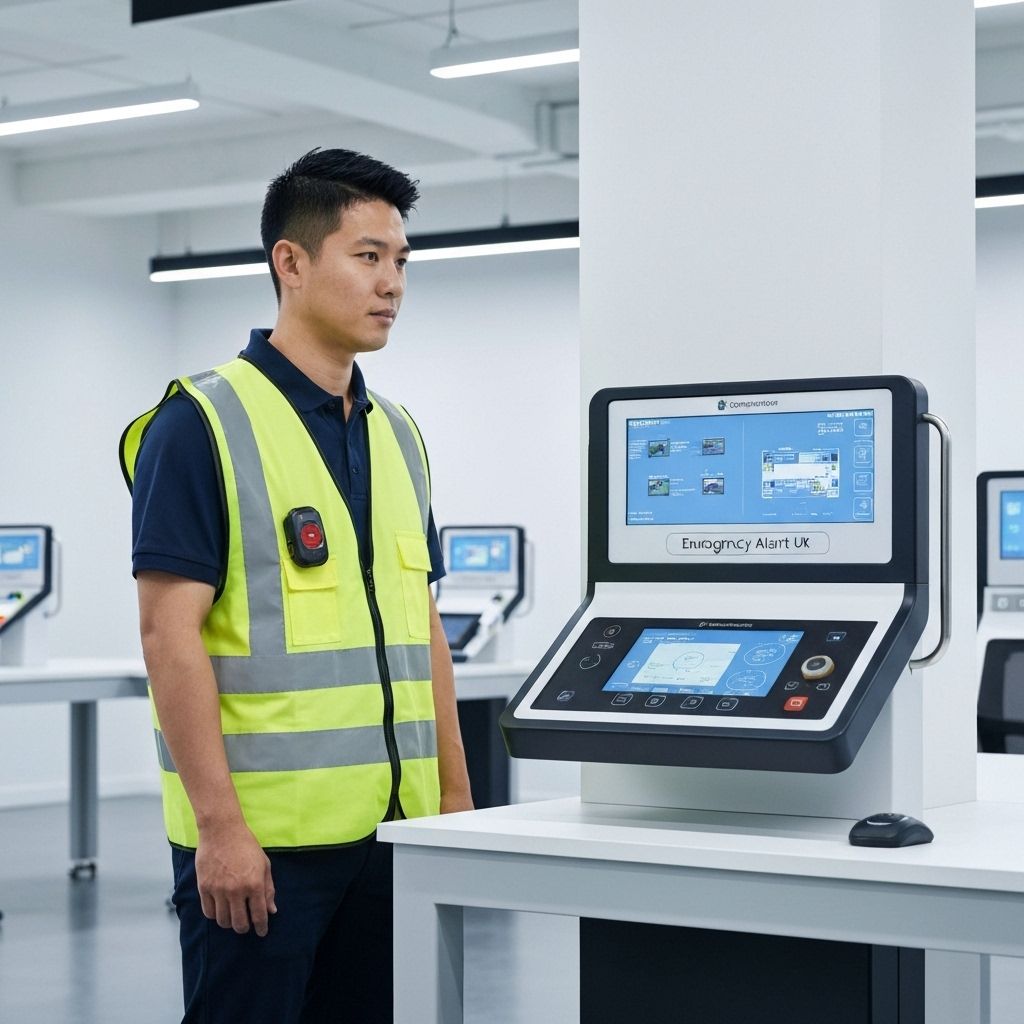Protecting Lone Workers: UK Legal Obligations and the Cost of Failure

# When Duty of Care Fails: UK Companies Fined Millions for Failing to Protect Lone Workers
The Health and Safety at Work Act 1974 places a fundamental duty on employers to ensure, so far as is reasonably practicable, the health, safety, and welfare of all employees. Yet enforcement data reveals a troubling pattern: companies continue to face significant prosecutions for failing to protect two particularly vulnerable groups—lone workers and employees travelling on company business.
The Scale of the Problem
Between 7 and 9 million workers in the UK are classified as lone workers, whilst work-related road traffic incidents remain a leading cause of workplace fatalities. Since 2016, the removal of upper limits on health and safety fines has resulted in penalties reaching into the millions, reflecting the severity with which courts now view these failures.
The message from regulators is clear: ignorance is not a defence, and inadequate risk management carries devastating financial and reputational consequences.
Major Prosecutions: Lone Worker Failures
Electricity North West: £900,000 Fine (2017)
In March 2017, an experienced linesman was carrying out routine maintenance on power lines when he discovered ivy growing on the lines. He positioned a ladder against a wooden pole and climbed to remove it. Tragically, it is believed he accidentally cut through his work positioning strap and fell six metres to his death.
The HSE's verdict was scathing. Inspectors were described as "scathing" about the complete lack of lone worker protection systems and planning. The company was fined £900,000 for breaching Section 2(1) of the Health and Safety at Work Act.
Key failings:
- No adequate lone worker monitoring system
- Insufficient planning for solo work at height
- Lack of emergency response protocols for isolated workers
- No means of communication or check-in procedures
London Borough of Brent: £100,000 Fine (2017)
On 21 July 2015, two social workers visited the home of a vulnerable child to carry out a safety assessment. Whilst taking notes, both were struck over the head with a metal object by the child's mother, with one worker knocked temporarily unconscious and later diagnosed with Post Traumatic Stress Disorder.
Westminster Magistrates' Court heard that Brent Council had failed to follow its own corporate lone working policy and violence and aggression guidance. No risk assessment was completed despite the mother having a known history of violence, and no aggression marker had been added to the case file.
HSE Inspector Neil Fry commented: "Violent and aggressive incidents are the third biggest cause of injuries reported to HSE from the health and social care sector. The local authority in this case failed to adhere to and implement its own systems and procedure for the management of lone working and violence and aggression against social workers."
The Action Group: £20,000 Fine (2018/2021)
On 27 December 2018, a 25-year-old female care worker visited a male service user with additional support needs at his Edinburgh home. During the visit, she was abducted, assaulted, sexually assaulted, and raped.
The HSE investigation revealed a catastrophic failure in risk assessment and employee protection. The Action Group had failed to make a suitable and sufficient assessment of the risks this specific service user posed to female employees, despite concerns being raised about safety with this particular resident since March 1994—more than 25 years of documented warnings.
HSE Inspector Kerry Cringan stated: "This was a harrowing case for all involved and could have been avoided by carrying out a suitable assessment of the risks, particularly those posed to female members of staff. If this had been done, appropriate control measures and safe working practices could have been put in place that would have protected their staff and prevented this incident."
Toby Baxter: £1,000 Fine + £6,161 Costs (2023/2025)
Laura Simmons, a 22-year-old shepherdess, was working alone on 2 June 2023, spraying weed killer along fence lines using an all-terrain vehicle at a farm in Charlton Abbots near Cheltenham. The overloaded quad bike overturned. She was found by a jogger several hours later but died from fatal spine injuries.
The HSE investigation found the ATV overturned due to an overloaded front rack, uneven tyre pressure, unstable load from lack of baffles in the spray tank, and the potential for the spray lance to be used during movement.
HSE Inspector Emily O'Neill remarked: "This was a tragic incident, and a much-loved young woman has lost her life. It could have easily been avoided with the right controls in place."
Major Prosecutions: Workers Travelling on Company Business
Renown Consultants Ltd: £450,000 Fine + £300,000 Costs (2013/2020)
On 19 June 2013, railway welders Zac Payne, just 20 years old, and Michael Morris, 48, died in a road traffic accident on the A1. The driver, Payne, had fallen asleep at the wheel whilst driving home from a night shift at approximately 5:30am—having left home 25 hours earlier at 4:30am the previous morning.
The Office of Rail and ORR prosecution revealed that Renown Consultants had accepted an urgent overnight repair request from Network Rail and sent the team without considering whether they were sufficiently rested. The workers had already completed a full day's work before the night shift.
Critical findings:
- Company failed to follow its own fatigue management policies
- Working time limits on safety-critical work were exceeded
- The pay and contract structure created incentives for staff to take unsafe shifts
- No proper driver eligibility checks were conducted
The Produce Connection: £30,000 Fine (2002/2006)
In what is believed to be the first case of its kind in the UK, The Produce Connection was fined for breaching health and safety legislation after employee Mark Fiebig died in a car crash even though the death occurred outside working hours.
Fiebig had worked four consecutive 19-hour days, totalling 76 hours in four days. He died when his car drifted into the path of an oncoming lorry as he drove home from work in October 2002. The court heard he was suffering from chronic fatigue and had fallen asleep at the wheel.
This case established a crucial precedent: employers are responsible for fatigue-related incidents caused by work patterns, even when they occur outside working hours.
The Legal Framework
Core Legislation
Health and Safety at Work Act 1974: Places duties on employers under Section 2(1) to ensure, so far as is reasonably practicable, the health, safety and welfare at work of all employees.
Management of Health and Safety at Work Regulations 1999: Requires employers to conduct thorough risk assessments and implement necessary safety measures, including for lone workers.
Corporate Manslaughter and Corporate Homicide Act 2007: Allows for fines ranging from £180,000 to £20 million where gross management failures lead to death.
Sentencing Guidelines
Since February 2016, the Sentencing Council guidelines have imposed a sliding scale of fines designed to ensure penalties impact companies proportionally regardless of size:
- Small companies (turnover £2m-£10m): Fines typically range from tens of thousands to hundreds of thousands
- Medium companies (turnover £10m-£50m): Fines can reach several million pounds
- Large companies (turnover £50m+): Fines range from £2.6 million to £10 million for the most serious offences, with no upper limit
Common Themes in Prosecutions
Analysis of these cases reveals consistent patterns:
1. Risk assessment failures: Companies either failed to conduct risk assessments or failed to act on identified risks
2. Inadequate monitoring systems: No effective way to check on lone workers' welfare or detect emergencies
3. Ignored existing policies: Organisations had policies but failed to implement or follow them
4. Fatigue management failures: No systems to monitor and control excessive working hours
5. Training deficits: Workers inadequately trained for the specific risks they faced
6. Communication breakdowns: No reliable means for workers to summon help in emergencies
The Real Cost of Non-Compliance
Beyond the immediate financial penalties, companies face:
- Increased insurance premiums that can persist for years
- Reputational damage affecting customer relationships and recruitment
- Director disqualification in cases of serious neglect
- Criminal records for both companies and individuals
- Civil liability for compensation claims from victims and families
- Lost productivity and operational disruption during investigations
Essential Safeguards: What Employers Must Do
For Lone Workers
Conduct comprehensive risk assessments:
- Identify all workers who work alone, even occasionally
- Assess the nature of the work, location, and specific hazards
- Consider the worker's experience, health, and training
- Review and update assessments regularly
Implement robust monitoring systems:
- Regular check-in procedures at predetermined times
- Automatic alarm systems that trigger if expected signals aren't received
- GPS tracking or location-sharing technology where appropriate
- Buddy systems or supervisor contact protocols
- Confirmation systems to verify workers have returned home safely
Provide adequate training:
- Specific hazards associated with working alone
- Emergency procedures and how to summon help
- Use of personal protective equipment and communication devices
- Violence and aggression management (for public-facing roles)
- Recognition of fatigue and stress indicators
Address violence and aggression risks:
- Flag known risks in client/location databases
- Conduct visits in controlled environments where risks are identified
- Provide two-person teams for high-risk situations
- Install panic alarms or personal safety devices
- Establish clear escalation procedures
For Workers Travelling on Company Business
Manage fatigue proactively:
- Implement maximum daily and weekly working hour limits
- Ensure compliance with Working Time Regulations
- Monitor actual hours worked, not just scheduled hours
- Build in adequate rest periods between shifts
- Create systems that flag and prevent scheduling of overtired workers
Assess journey-related risks:
- Include travel time in working hour calculations
- Consider journey length, time of day, and route conditions
- Assess driver competency and vehicle suitability
- Plan routes to avoid excessive driving hours
- Provide alternatives to driving when workers are fatigued
Implement driver checks:
- Verify driving licences are valid and appropriate for vehicle type
- Ensure insurance coverage matches vehicle usage and driver age
- Conduct regular vehicle maintenance and safety checks
- Provide driver training and refresher courses
- Monitor incident reports and near-misses
The Role of Technology
Modern lone worker protection solutions include:
- Man-down devices: Detect falls or lack of movement and automatically alert responders
- Check-in apps: Require periodic confirmation of safety, raising alarms if missed
- GPS tracking: Enable rapid location of workers in emergency
- Two-way communication devices: Allow instant contact with emergency services or supervisors
- Panic buttons: Provide discreet means to summon immediate help
- Fatigue management software: Automatically tracks working hours and prevents over-scheduling
Conclusion
The prosecutions detailed above represent more than statistics—they are personal tragedies that devastated families and could have been prevented. The HSE conviction rate for health and safety prosecutions stands at approximately 93%, demonstrating that when cases reach court, employers are overwhelmingly found to have failed in their duties.
For lone workers and employees travelling on company business, the risks are real and the consequences of inadequate protection can be fatal. Yet the solutions are neither complex nor prohibitively expensive. What's required is recognition of the risks, implementation of appropriate controls, and most critically, a genuine commitment to worker safety that goes beyond mere policy documents.
As HSE data shows, 87% of companies prosecuted in 2018 for health and safety breaches were charged for failing to adequately assess risk. This suggests that many incidents stem not from sophisticated or unpredictable hazards, but from fundamental failures to identify and manage known risks.
The question for every employer is stark: Will you wait for a tragedy to reveal your gaps, or will you act now to protect your most valuable asset—your people?
This article is based on publicly available information about UK health and safety prosecutions and general principles of UK employment law. Organisations should consult with qualified health and safety professionals and legal advisers to ensure compliance with their specific regulatory obligations and to develop appropriate risk management strategies.
Ready to Enhance Your Crisis Communication?
See how Is Everyone Safe can help protect your people during emergencies.

